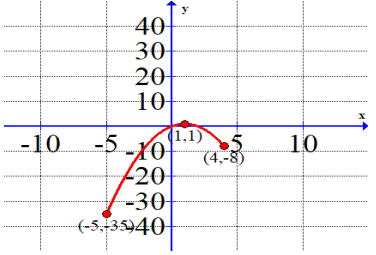FIND ABSOLUTE MAXIMUM AND MINIMUM VALUE OF A FUNCTION`
What is absolute maximum ? :
An absolute maximum point is a point where the function obtains its greatest possible value.
What is absolute minimum ?
An absolute minimum point is a point where the function obtains its least possible value.
Working rule :
Step 1 :
Let us assume the given function as f(x). Find the first derivative, that is f'(x).
Step 2 :
Equate the first derivative to 0. That is f'(x) = 0 and solve for the variable.
Step 3 :
The values will lie in between the given interval. These values are called critical numbers.
Apply the critical numbers and values we find in the closed interval in f(x).
- For what value of x, we get the maximum value of y, that can be fixed as absolute maximum.
- For what value of x, we get the minimum value of y, that can be fixed as absolute minimum.
Problem 1 :
The function g is given by
g(x) = 4x3 + 3x2 - 6x + 1
what is the absolute minimum value of g on the closed interval [-2, 1] ?
A) -7 B) -3/4 C) 0 D) 2 E) 6
Solution :
g(x) = 4x3 + 3x2 - 6x + 1
g'(x) = 4(3x2) + 3(2x) - 6(1) + 0
g'(x) = 12x2 + 6x - 6
g'(x) = 0
12x2 + 6x - 6 = 0
6(2x2 + x - 1) = 0
(x + 1)(2x - 1) = 0
x = -1 and x = 1/2
Critical numbers are -1 and 1/2.
Applying x = -2
g(x) = 4x3 + 3x2 - 6x + 1
g(-2) = 4(-2)3 + 3(-2)2 - 6(-2) + 1
= -32 + 12 + 12 + 1
= -7
Applying x = -1
g(-1) = 4(-1)3 + 3(-1)2 - 6(-1) + 1
= -4 + 3 + 6 + 1
= 6
Applying x = 1/2
g(1/2) = 4(1/2)3 + 3(1/2)2 - 6(1/2) + 1
= 1/2 + 3/4 - 3 + 1
= 1/2 + 3/4 - 2
= (2+3-8)/4
= -3/4
Applying x = 1
g(1) = 4(1)3 + 3(1)2 - 6(1) + 1
= 4 + 3 - 6 + 1
= 8 - 6
= 2
Minimum value is at (-2, -7). So, option A is correct.
Problem 2 :
Find the absolute maximum and absolute minimum of the function under the given interval.
f(x) = 4x3 − 108x ; [0,5]
Solution :
f(x) = 4x3 − 108x
f'(x) = 4(3x2) - 108(1)
f'(x) = 12x2 - 108
f'(x) = 0
12(x2 - 9) = 0
x2 - 9 = 0
(x + 3)(x - 3) = 0
x = -3 and x = 3
-3 is not in the interval.
f(0) = 4(0)3 − 108(0) ==> 0
f(3) = 4(3)3 − 108(3) ==> -216
f(5) = 4(5)3 − 108(5) ==> -40
Absolute maximum is at (0, 0) and absolute minimum is at (3, -216).
Problem 3 :
Find the absolute maximum and absolute minimum

Solution :
Minimum are at (-5, -35) and (4, -8)
Maximum is at (1, 1).
Absolute minimum is at (-5, -35) and absolute maximum is at (1 ,1).
Problem 4 :
Find the absolute maximum and absolute minimum

Solution :
Absolute minimum is at (-3, -15)
Absolute maximum is at (4, 34).
Problem 5 :
Let f be the function given by f(x) = x - 2 sin x for 0 ≤ x ≤ 2π
a) Find the intervals on which f is increasing and decreasing.
b) Find the absolute minimum and maximum value on the given interval.
Solution :
f(x) = x - 2 sin x
f'(x) = 1 - 2 cos x
f'(x) = 0
1 - 2 cos x = 0
2 cos x = 1
cos x = 1/2
x = cos-1 (1/2)
x = π/3 and 5π/3
Dividing into intervals :
(0, π/3) (π/3, 5π/3) and (5π/3, 2π)
Finding increasing and decreasing interval :
(0, π/3)
x = π/4
f'(π/4) = 1 - 2 cos (π/4)
= 1 - 2 (√2/2)
= 1 - √2 < 0 (decreasing)
(π/3, 5π/3)
x = π/2
f'(π/2) = 1 - 2 cos (π/2)
= 1 - 0
= 1 > 0 (increasing)
(5π/3, 2π)
x = 330 degree
f'(π/2) = 1 - 2 cos (330)
= 1 - 2sin 60
= 1 - 2(√3/2)
= 1 - √3 (decreasing)
Decreasing on (0, π/3) U(5π/3, 2π) and increasing on (π/3, 5π/3).
Critical numbers are x = π/3 and 5π/3.
f(x) = x - 2 sin x
f(0) = 0 - 2 sin 0 ==> 0
f(π/3) = π/3 - 2 sin (π/3) ==> π/3 - √3
f(5π/3) = 5π/3 - 2 sin (5π/3) ==> 5π/3 + √3
So, absolute maximum is 5π/3 + √3 and absolute minimum is π/3 - √3.
Recent Articles
-
Finding Range of Values Inequality Problems
May 21, 24 08:51 PM
Finding Range of Values Inequality Problems -
Solving Two Step Inequality Word Problems
May 21, 24 08:51 AM
Solving Two Step Inequality Word Problems -
Exponential Function Context and Data Modeling
May 20, 24 10:45 PM
Exponential Function Context and Data Modeling